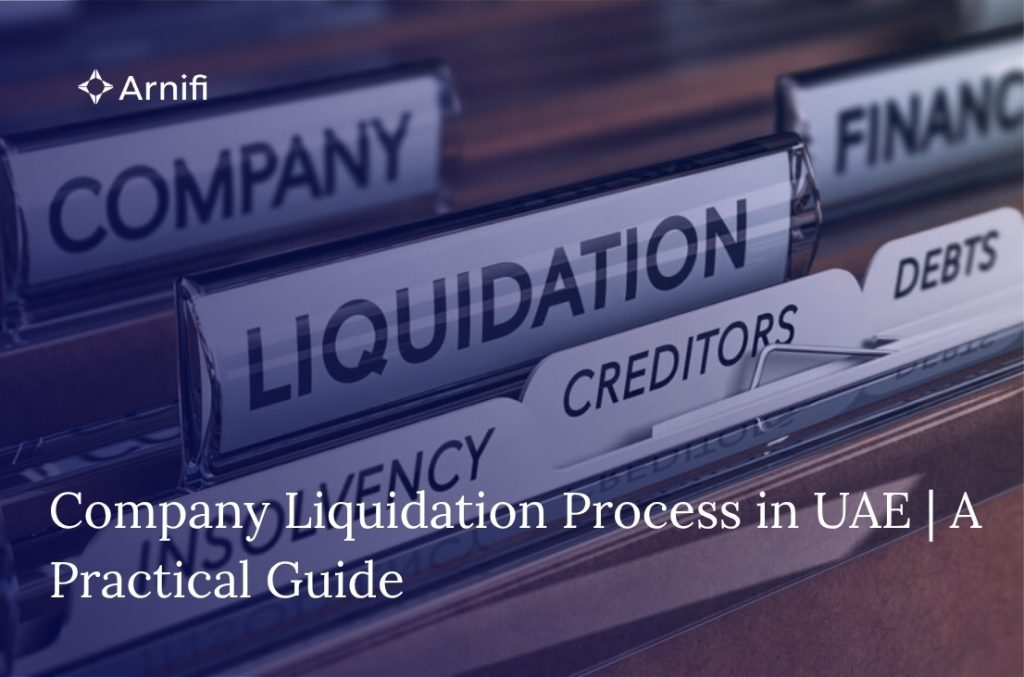Company Liquidation Process in UAE | A Practical Guide
by
Rifa S Laskar
Nov 19, 2025  7 MIN READ
7 MIN READ

Company liquidation in the UAE is the formal closure of a business. It includes winding up operations and settling all liabilities. Also, cancelling the trade license is part of this process, so read carefully.
Federal Decree-Law No. 32 of 2021 on Commercial Companies sets the broad rules for dissolution and the appointment of a liquidator.
A Dubai mainland company will usually pass through the Department of Economy and Tourism and related Dubai government portals. A free zone entity will follow the checklist of its registrar, for example DMCC or RAKEZ.
This guide maps the company liquidation process end-to-end so finance and legal teams can close books cleanly, return capital, and exit with minimal review friction.
Table of contents
- What Liquidation Means Under the Companies Law?
- Company Liquidation Process in UAE and Responsibilities
- Step-By-Step Timeline For Company Closure In Dubai
- How The Liquidator Handles Notices and Final Accounts
- How to Order Staff and Immigration Cancellations
- Tax Deregistration Through Emaratax Is Part of the Critical Path
- Document Checklist That Prevents Repeat Portal Uploads
- Understanding the DMCC Route and Why It Is Portal-Driven
- DMCC Steps Summarised for Planning
- How Cash and Contracts Affect The Liquidation Timeline?
- How the Mainland and Free-Zone Requirements Interact With the Law
- Frequent Mistakes That Slow Liquidation and How to Avoid Them
What Liquidation Means Under the Companies Law?
Under the Commercial Companies Law, dissolution starts a formal sequence. An appointed liquidator leads the process. The liquidator represents the company during wind-down and settles liabilities.
The liquidator prepares a final report for removal by the registrar, and the law defines director duties and filing obligations during liquidation.
Registrars may demand public notices and creditor settlement evidence. They may also require audited closing numbers, depending on the legal form.
Company Liquidation Process in UAE and Responsibilities
Under the Commercial Companies Law, dissolution starts a formal sequence.
- An appointed liquidator leads the process.
- The liquidator represents the company during wind-down and settles liabilities.
- The liquidator prepares a final report for removal by the registrar.
- The law defines director duties and filing obligations during liquidation.
- Registrars may demand public notices and creditor settlement evidence.
- Registrars may also require audited closing numbers, depending on the legal form.
This is the company liquidation process in Dubai in practice. However, the exact document order can vary with activity and outstanding filings.
Step-By-Step Timeline For Company Closure In Dubai
- Pass a shareholder resolution to liquidate and appoint a licensed liquidator under the Companies Law.
- Prepare the liquidator engagement, opening inventory of assets and liabilities, and notice requirements as the registrar may direct.
- Clear payroll and end-of-service dues. Cancel residence visas and establishment links with GDRFA after labour cancellations.
- File VAT deregistration in EmaraTax once taxable activities cease; obtain the certificate.
- File Corporate Tax deregistration in EmaraTax if registered; resolve any return or payment balance.
- Apply to cancel the trade licence with DET (mainland) or the relevant free-zone registrar.
- Submit the liquidator’s final report and close bank accounts after regulator confirmations.
How The Liquidator Handles Notices and Final Accounts
Once appointed, the liquidator assumes conduct of the wind-down. Depending on the registrar, the liquidator issues public notices, receives creditor claims, realises assets, and prepares a final statement of account.
The registrar then removes the company after reviewing the liquidator’s report and required clearances. The Companies Law allocates responsibility to managers and directors for proper filings during this period from trusted sources.
If the process of managing it feels confusing, hire professional accounting and bookkeeping services in UAE to keep record of every transaction correctly and keep the financial statements clean for audits and tax checks.
How to Order Staff and Immigration Cancellations
Labour cancellations must precede residence-visa cancellations for sponsored staff. Cancelling work permits and employment contracts can be done via MOHRE.
GDRFA then cancels residence permits and updates sponsorship records. If the entity sponsored dependents, those residencies must be cleared as well.
Keep copies of MOHRE cancellations and GDRFA confirmations in the final pack. It shortens later queries from bank compliance teams and registrars.
Tax Deregistration Through Emaratax Is Part of the Critical Path
When activities stop, VAT accounts are deregistered through EmaraTax; the FTA page provides the exact steps and issues a deregistration certificate once approved. Corporate Tax deregistration is a separate service in EmaraTax.
It ends return obligations after closure, merger, or other eligible events. Teams should reconcile final returns to the liquidator’s accounts to avoid residual liabilities.
Document Checklist That Prevents Repeat Portal Uploads
- Shareholder resolution to liquidate and to appoint the liquidator
- Liquidator appointment letter and licence copy
- MOHRE cancellation confirmations and WPS final payroll proofs
- GDRFA residence-visa cancellation confirmations for employees and partners
- FTA VAT deregistration certificate and Corporate Tax deregistration acknowledgment
- Bank liability clearance letters and utilities or landlord NOCs
- Audited closing numbers and the liquidator’s final report
Understanding the DMCC Route and Why It Is Portal-Driven
The DMCC company liquidation process runs end-to-end on the DMCC portal. The authority’s guidance shows:
- Staged uploads
- Cancellation of active visas and cards through the portal
- Submission of original documents at the final stage
- Licence termination after review.
Important Advice: DMCC also issues enhanced winding-up notes that describe registrar access changes during termination and the liquidator’s role in submissions. The practical takeaway is simple: map the internal timeline to the portal stages before starting.
DMCC Steps Summarised for Planning
- Complete the first set of termination requirements and submit through the DMCC portal
- Cancel all active visas, permanent and temporary access cards via the portal
- Upload the second set of requirements and submit originals as directed
- Receive licence termination after registrar review and liquidator filings
How Cash and Contracts Affect The Liquidation Timeline?
Supplier reconciliations, bank loan closures, and asset sales can lengthen the calendar even when portal tasks are done quickly. Where leases or long-term contracts exist, a documented settlement or assignment avoids later objections during licence cancellation.
For companies with VAT recoverables, the liquidator should factor remaining refunds against the cost of keeping the account open, balancing speed with recoveries. Closing bank accounts usually waits until all regulator acknowledgements are in hand. However, early discussions with the relationship manager keep the last step smooth.
How the Mainland and Free-Zone Requirements Interact With the Law
Registrars administer practical steps, but the legal base remains the Commercial Companies Law. That is why the same principles appear across platforms: pass a resolution, appoint a liquidator, call in claims, settle dues, submit final accounts, then remove the entity.
Mainland DET websites and free-zone handbooks simply turn these rules into online forms and checklists. If a business group has many companies, using one common template for board resolutions and closure documents makes the process faster and more consistent.
Frequent Mistakes That Slow Liquidation and How to Avoid Them
Mistake: Labour records cancelled after visa submissions, leading to GDRFA rejects
Solution: Cancel in MOHRE first, then cancel visas.
Mistake: Tax accounts left active until late, causing return gaps
Solution: Start EmaraTax deregistration as soon as taxable supplies cease.
Mistake: Missing liquidator authority in the board resolution
Solution: Ensure the resolution names the liquidator and authorises filings under the Companies Law.
Mistake: Mainland licence cancellation filed before receiving utility or landlord clearances, prompting portal returns
Solution: Follow DET guidance in order.
Conclusion
A company liquidation process in UAE aligns four threads at once. These include corporate law steps, registrar portals, labour and immigration cancellations, and tax deregistration. When the liquidator’s plan, the registrar’s screens, and EmaraTax timelines run together, closure becomes a predictable project.
For professional assistance, visit Arnifi, a leading accounting and bookkeeping platform in UAE. Our expert team prepares the resolution and liquidator file, sequences MOHRE and GDRFA cancellations, and completes VAT and Corporate Tax deregistration so the licence terminates cleanly and capital returns on time.
Top UAE Packages

Related Articles
Top UAE Packages



